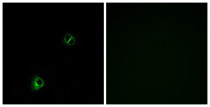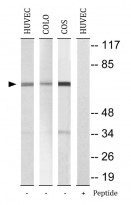ARG66638
anti-FZD9 / Frizzled 9 antibody
anti-FZD9 / Frizzled 9 antibody for ICC/IF,Western blot and Human,Monkey
Overview
| Product Description | Rabbit Polyclonal antibody recognizes FZD9 / Frizzled 9 |
|---|---|
| Tested Reactivity | Hu, Mk |
| Tested Application | ICC/IF, WB |
| Host | Rabbit |
| Clonality | Polyclonal |
| Isotype | IgG |
| Target Name | FZD9 / Frizzled 9 |
| Antigen Species | Human |
| Immunogen | Synthetic peptide between aa. 520-600 of Human FZD9 / Frizzled 9. |
| Conjugation | Un-conjugated |
| Alternate Names | Frizzled-9; Fz-9; FZD3; CD349; FzE6; CD antigen CD349; hFz9 |
Application Instructions
| Application Suggestion |
|
||||||
|---|---|---|---|---|---|---|---|
| Application Note | * The dilutions indicate recommended starting dilutions and the optimal dilutions or concentrations should be determined by the scientist. | ||||||
| Observed Size | ~ 65 kDa |
Properties
| Form | Liquid |
|---|---|
| Purification | Affinity purification with immunogen. |
| Buffer | PBS, 0.02% Sodium azide, 50% Glycerol and 0.5% BSA. |
| Preservative | 0.02% Sodium azide |
| Stabilizer | 50% Glycerol and 0.5% BSA |
| Concentration | 1 mg/ml |
| Storage Instruction | For continuous use, store undiluted antibody at 2-8°C for up to a week. For long-term storage, aliquot and store at -20°C. Storage in frost free freezers is not recommended. Avoid repeated freeze/thaw cycles. Suggest spin the vial prior to opening. The antibody solution should be gently mixed before use. |
| Note | For laboratory research only, not for drug, diagnostic or other use. |
Bioinformation
| Database Links | |
|---|---|
| Gene Symbol | FZD9 |
| Gene Full Name | frizzled class receptor 9 |
| Background | Members of the 'frizzled' gene family encode 7-transmembrane domain proteins that are receptors for Wnt signaling proteins. The FZD9 gene is located within the Williams syndrome common deletion region of chromosome 7, and heterozygous deletion of the FZD9 gene may contribute to the Williams syndrome phenotype. FZD9 is expressed predominantly in brain, testis, eye, skeletal muscle, and kidney. [provided by RefSeq, Jul 2008] |
| Function | Receptor for Wnt proteins. Most of frizzled receptors are coupled to the beta-catenin canonical signaling pathway, which leads to the activation of disheveled proteins, inhibition of GSK-3 kinase, nuclear accumulation of beta-catenin and activation of Wnt target genes. A second signaling pathway involving PKC and calcium fluxes has been seen for some family members, but it is not yet clear if it represents a distinct pathway or if it can be integrated in the canonical pathway, as PKC seems to be required for Wnt-mediated inactivation of GSK-3 kinase. Both pathways seem to involve interactions with G-proteins. May be involved in transduction and intercellular transmission of polarity information during tissue morphogenesis and/or in differentiated tissues. [UniProt] |
| Cellular Localization | Cell membrane; Multi-pass membrane protein. Note=Relocalizes DVL1 to the cell membrane leading to phosphorylation of DVL1 and AXIN1 relocalization to the cell membrane. [UniProt] |
| Calculated MW | 64 kDa |
| PTM | Ubiquitinated by ZNRF3, leading to its degradation by the proteasome. [UniProt] |
Images (4) Click the Picture to Zoom In
-
ARG66638 anti-FZD9 / Frizzled 9 antibody ICC/IF image
Immunofluorescence: A549 cells stained with ARG66638 anti-FZD9 / Frizzled 9 antibody. The picture on the right is blocked with the synthetic peptide.
-
ARG66638 anti-FZD9 / Frizzled 9 antibody WB image
Western blot: HUVEC lysate stained with ARG66638 anti-FZD9 / Frizzled 9 antibody.
-
ARG66638 anti-FZD9 / Frizzled 9 antibody WB image
Western blot: HUVEC, COLO and COS cell lysates stained with ARG66638 anti-FZD9 / Frizzled 9 antibody. The lane on the right is blocked with the synthetic peptide.
-
ARG66638 anti-FZD9 / Frizzled 9 antibody WB image
Western blot: Jurkat cell lysate stained with ARG66638 anti-FZD9 / Frizzled 9 antibody.









